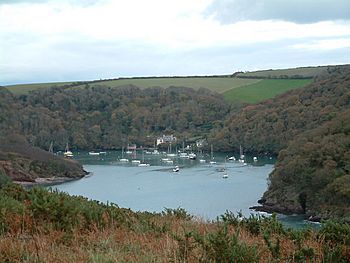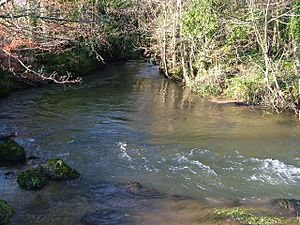River Yealm facts for kids
Quick facts for kids River Yealm |
|
|---|---|
 |
|
| Country | England |
| County | Devon |
| Physical characteristics | |
| River mouth | 50°18′38.8″N 4°4′13.5″W / 50.310778°N 4.070417°W |
| Length | 12 miles (19 km) |
The River Yealm is a beautiful river in Devon, England. It starts high up on Stall Moor in south Dartmoor, about 430 meters (1,411 feet) above sea level. From there, it flows for about 12 miles (19 kilometers) all the way to the sea.
Along its journey, the River Yealm passes through several places. These include Cornwood, Lee Mill, and Yealmpton. Yealmpton is the biggest village along the river, with about 2,000 people living there. Finally, the river reaches its wide mouth, called an ria. A ria is like a drowned river valley, where the sea has filled in the river's path. This ria is bordered by Wembury on one side. On the other side, it forms a deep inlet for the villages of Newton Ferrers and Noss Mayo.
The Yealm Estuary and Its Neighbors
The mouth of the River Yealm is a special place where the river meets the sea. This area is managed by a group of people from the nearby towns. These towns include Wembury, Yealmpton, Brixton, and "Newton and Noss." They work together to look after the river and its estuary.
The River Yealm is located between two other important rivers in Devon. To its west is the River Plym, which flows into the sea at Plymouth. To its east is the River Erme, which reaches the sea near Meadowsfoot Beach in Holbeton parish.
History of Fish in the River Yealm
Long ago, the River Yealm was full of fish. It had many salmon, sea trout, and brown trout. These fish were very common here. However, since the 1940s, the number of these fish has gone down. Even with fewer trout and salmon, the river is still very important for other types of aquatic life.
Amazing Aquatic Life
Even though some fish numbers have dropped, the River Yealm is still a very important place for nature. It is a special area that helps protect many different kinds of animals and plants. The river is known as a "nursery" for bass fish, meaning young bass grow up here.
Because of its importance, the River Yealm is called a Special Area of Conservation (SAC). It is also a Site of Special Scientific Interest (SSSI). These titles mean the river is protected because it supports many rare or important species.
If you visit the shore at low tide during the right season, you might find cockles and wild oysters. These shellfish live in the mud and sand.
The Yealm estuary has a large area perfect for growing oysters. Part of this area has been used for a long time to farm oysters. Oysters need tiny plants called phytoplankton to eat. These phytoplankton grow very well in the Yealm estuary. This is because the mix of fresh river water and salty seawater is just right. The nutrients from both types of water help the phytoplankton grow quickly. Also, during neap tides (when tides are not very strong), the phytoplankton are not all washed out to sea. This balance makes the Yealm estuary a great place for shellfish to thrive. Not all estuaries in South Devon are this perfect. For example, the Kingsbridge Estuary gets too little fresh water, while the Dart gets too much.


